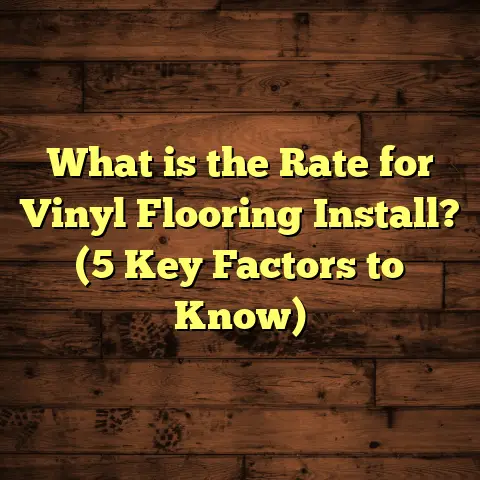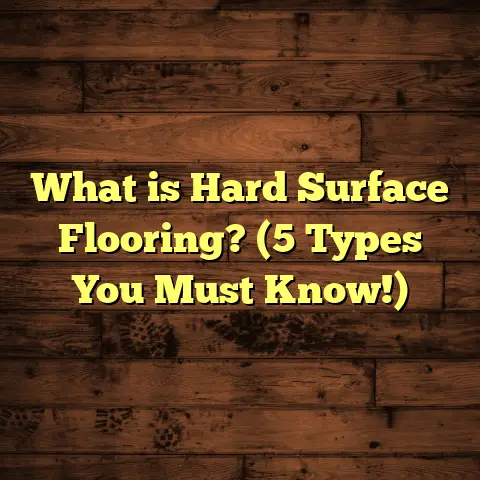What is Floor Protection for Contractors? (5 Essential Methods)
A curious thing happens in construction: the very floor you pour your heart, sweat, and time into can be marred before the project even wraps up. How can something so foundational, literally beneath your feet, become so vulnerable? This paradox is what led me to focus on floor protection for contractors — a topic often overlooked but critical.
What is Floor Protection for Contractors?
So, what is floor protection for contractors? Simply put, it’s the set of methods and materials used to shield finished or existing floors from damage during construction or renovation work.
Think about it: once a hardwood floor is installed, or tiles are laid, the surface is prone to scratches, dents, stains, and spills from tools, paint, or heavy foot traffic before the client even steps inside for the first time. Floor protection acts as a barrier to keep these surfaces safe.
In my years on job sites, I’ve seen floors ruined by accidental drops of paint buckets, scuffed boots, or heavy equipment rolling over delicate surfaces. Protecting floors isn’t just about avoiding extra repair costs; it’s about preserving reputation and client trust.
Damage to floors during construction isn’t rare. According to industry reports, around 30% of post-construction repair expenses stem from floor damage. This adds up fast when you consider luxury flooring can cost anywhere from $8 to $20 per square foot or more.
The paradox is this: floors are among the first things installed but often the last thing protected properly.
Why Floor Protection Matters So Much
Have you ever walked onto a freshly installed hardwood floor only to spot a scratch or dent? I have — many times. It’s frustrating because these damages are preventable with the right approach.
When I first started out as a contractor, I underestimated floor protection’s importance. Early on, I treated it as an afterthought. But after a costly mistake on a client’s home where drywall mud splattered on pristine oak floors, I learned the hard way.
That experience taught me:
- Clients notice every flaw on new floors.
- Repairing or replacing damaged flooring can delay projects by days or weeks.
- Costs for fixing damage can exceed what was saved by skipping protection.
Protecting floors is not just about covering them; it’s part of managing risk on-site. It affects scheduling, budgeting, and client satisfaction.
My Journey with Floor Protection
Let me share how my approach evolved over time.
One of my earliest jobs was installing engineered hardwood in a boutique hotel lobby. We finished the floors ahead of schedule but forgot to protect them before other trades moved in. Within days, scuffs and dirt marks appeared everywhere.
I remember standing there, heart sinking, realizing how easy this damage was to avoid. From then on, I made floor protection a core part of my workflow.
On another project — a suburban custom home — we used rosin paper combined with adhesive film and temporary carpeting. The difference was night and day. No scratches, no stains. The client was thrilled. That success reaffirmed my belief that investing in good protection pays dividends.
Five Essential Methods of Floor Protection
Let me walk you through five key methods I rely on to keep floors intact during projects.
1. Protective Coverings: Paper, Plastic, and Mats
Using protective coverings is the most common approach. Here’s the lowdown:
- Rosin paper: Affordable and breathable, rosin paper is great for hardwood floors. It offers modest protection against dust and light scratches but isn’t waterproof.
- Plastic sheeting: Offers waterproof protection but can trap moisture underneath, which might harm wood floors if left too long.
- Floor protection mats: Heavy-duty mats provide excellent impact resistance and are reusable. They’re perfect for high-traffic zones.
In one kitchen remodel, we layered rosin paper with plastic sheeting to get the best of both worlds. This combo kept dust out while guarding against paint spills.
Why Rosin Paper?
Rosin paper has been a staple in construction for decades. It’s cost-effective (about $0.50 to $1 per square foot) and easy to handle. Its breathability lets moisture escape, reducing risk of mold or warping on wood floors. However, it tears easily under heavy traffic or sharp objects.
Plastic Sheeting Pros and Cons
Plastic sheeting costs roughly $0.15 to $0.30 per square foot. It blocks moisture and protects against liquids well but can trap condensation under it if used improperly on wood floors. That trapped moisture can cause cupping or swelling over time if left in place too long.
Floor Protection Mats
Reusable mats like those made by Ram Board or similar brands cost more upfront ($1–$3 per square foot) but save money long-term because they’re durable and provide excellent impact resistance against dropped tools or heavy equipment rolling over floors.
Layering Materials for Best Effect
Sometimes a single material isn’t enough. Combining rosin paper with plastic sheeting or mats gives layered protection that guards against both moisture and physical damage.
In one project with hardwood floors and lots of painting/trades involved, we used:
- Rosin paper as base layer (breathable)
- Plastic sheeting on top in areas prone to spills
- Mats in high-traffic zones
This approach prevented all visible damage despite weeks of work.
2. Temporary Carpeting
Ever tried rolling out temporary carpet? It’s a game-changer on carpeted floors or concrete slabs.
Temporary carpets are designed to absorb impact and prevent dirt infiltration. I’ve used brands like Ram Board that are durable yet easy to install and remove.
One big warehouse project had us dealing with constant forklift traffic. The temporary carpet kept the concrete slab pristine despite heavy loads rolling over it daily.
Temporary carpet is especially useful when you want a soft surface that won’t shift or peel like plastic can. It also helps reduce noise from foot traffic during work.
Cost & Installation
Temporary carpet runs around $0.80 to $1.50 per square foot depending on quality. Installation involves rolling out sheets and taping edges securely down with painter’s tape or gaffer tape.
3. Adhesive Floor Protection Films
These thin films stick directly onto surfaces like hardwood or tile without damaging them upon removal.
They’re fantastic for short-term protection during quick jobs like painting or electrical work. However, I caution clients on longer projects because adhesives can leave residue if left on too long or in hot conditions.
I’ve used adhesive films on commercial jobs where floors needed protection for just a few days. The film peeled off cleanly without affecting finishes — a real time saver compared to laying down paper or mats.
Key Points:
- Best for smooth surfaces (hardwood, tile)
- Lasts up to 30 days without residue (manufacturer-dependent)
- Can cost $1–$2 per square foot
4. Runners and Tape
Runners are narrow strips of protective material placed along high-traffic walkways inside buildings. Paired with painter’s tape, they keep floors safe without covering entire rooms.
I often use this method in small remodels or when work is limited to specific areas. Just make sure to use tape that won’t peel off the finish or leave sticky residue.
An example: A client had just installed beautiful porcelain tiles but only part of the home was under renovation. We ran 3-foot-wide runners along hallways where workers passed frequently and taped them down carefully.
It’s cost-effective and targeted protection without smothering entire floor surfaces unnecessarily.
5. Custom Crates and Barriers
Sometimes, protection isn’t just about coverings but physical barriers.
On sites with heavy equipment or large material deliveries, we build custom crates or barriers around sensitive flooring areas to prevent accidental contact or drops.
This method was key on a museum restoration project where marble floors demanded absolute caution.
We fabricated wooden crates around marble flooring sections during bulky equipment moves and stored tools away from these zones strictly enforced by site supervisors.
Barriers add an extra layer of physical protection when simple coverings aren’t enough due to risk level or activity intensity.
Common Mistakes Contractors Make with Floor Protection
Let me share some frequent errors I’ve seen — some made by myself early on — so you can avoid them:
- Underestimating material needs: Ordering too little protective covering results in gaps that expose floors to damage.
- Using wrong materials for floor type: Plastic sheeting on hardwood without ventilation causes moisture issues; adhesive films on textured tile don’t stick well.
- Not securing coverings properly: Sheets that shift underfoot create tripping hazards and expose floors anyway.
- Leaving protection on too long: Some materials degrade finishes if left in place beyond recommended times.
- Ignoring waste factors: Not including extra 10–15% material for overlaps and seams leads to shortages mid-job.
From my own experience, adding 15% extra coverage for waste has saved many headaches in ordering supplies accurately.
Advanced Techniques & Technologies in Floor Protection
Technology has brought new products that make protecting floors easier and more reliable:
- Self-adhesive protective films with UV resistance: These prevent yellowing or degradation when exposed to sunlight through windows during long projects.
- Reinforced mats with rubber backing: These mats don’t slip at all and offer superior resilience under heavy machinery like forklifts or lifts.
- Eco-friendly recyclable materials: Some manufacturers now offer biodegradable rosin paper alternatives reducing environmental impact post-project disposal.
- Smart sensors embedded under mats: A recent innovation where sensors alert supervisors if someone steps off designated walkways risking floor damage (still emerging tech).
Real-Life Case Study: Protecting Floors in a Historic Home Renovation
To illustrate how critical floor protection is, here’s a detailed case study from my portfolio:
Project Overview
A 1920s historic home with original oak flooring undergoing full interior renovation including plumbing upgrades, electrical rewiring, and drywall replacement.
Challenge
Oak floors were fragile after nearly 100 years of wear; direct foot traffic and construction debris could cause irreversible damage.
Solution
- Laid rosin paper throughout all living areas as base layer
- Added adhesive film in kitchens and bathrooms prone to water spills
- Installed thick floor mats near entry points where workers entered/exited carrying heavy tools
- Built temporary barriers around main staircase landing (another vulnerable spot)
Results
Despite months of work with multiple trades involved:
- No visible scratches or stains on oak floors post-renovation
- Client praised preservation effort as key reason for smooth project approval by historic commission
- Saved an estimated $10,000+ compared to potential floor repairs/replacement costs
This experience reinforced my view that investing time and money upfront in floor protection pays off immensely downstream.
How to Calculate Floor Protection Costs Accurately
Budgeting properly is crucial so you don’t overspend or fall short mid-project:
- Measure total protected area: Get accurate square footage of all areas needing coverage including overlaps at edges and seams (add 10–15% waste).
- Select materials based on floor type & job duration: Factor in costs per square foot for rosin paper, mats, plastic sheets, etc., plus any tape or adhesives required.
- Include labor costs: Installing coverings takes time; budget for crew hours accordingly (usually 1–2 hours per 1,000 sq ft).
- Account for removal & disposal: Some materials require special disposal fees depending on local regulations.
- Plan contingencies: Have a small reserve budget (~5%) for unexpected needs like patching uncovered spots or replacing damaged protection during work.
Here’s a rough example for a 2,000 sq ft hardwood floor project:
| Material | Cost/Sq Ft | Quantity (sq ft) | Total Cost |
|---|---|---|---|
| Rosin Paper | $0.75 | 2,300 (incl waste) | $1,725 |
| Plastic Sheeting | $0.25 | 500 | $125 |
| Adhesive Film | $1.50 | 400 | $600 |
| Painter’s Tape & Supplies | Lump Sum | – | $150 |
| Labor (installation/removal) | Hourly | 10 hours | $300 |
| Total Estimated Cost | $2,900 |
Compared to potential repair costs of $12k+ for floor damage on this scale — this investment makes sense financially and reputation-wise.
Maintenance Tips During Construction Projects
Protecting floors isn’t just about installing barriers; maintenance throughout the project matters too:
- Inspect coverings daily for tears or shifts; patch holes immediately
- Clean debris off protective layers regularly to avoid grit damaging underlying floors
- Keep wet materials contained; mop spills promptly even on covered floors
- Communicate clearly with all trades about respecting protected zones
A small daily effort here prevents big headaches later when damage shows up unexpectedly at final walkthroughs.
Stories from the Field: When Floor Protection Saved the Day
I want to share some moments that stuck with me because they show floor protection’s value vividly:
Story #1: The Paint Bucket Spill
On a mid-size remodel job, one painter accidentally knocked over a full gallon bucket of dark stain near hardwood stairs covered only with rosin paper beneath plastic sheeting. Because layering was done well and plastic was intact, the stain didn’t seep through to the floor below—cleanup was quick with no damage at all. A close call that reinforced layering importance!
Story #2: Forklift in Warehouse Build
A new industrial warehouse had polished concrete slabs newly poured before shelving installation began. We laid industrial-grade temporary carpet runner mats throughout loading zones anticipating forklift traffic nonstop for weeks. Not one scratch appeared despite dozens of trips daily carrying heavy pallets — impressive given how unforgiving concrete can be when scuffed.
Final Thoughts: Protecting Floors Isn’t Optional
If you’re like me and want your projects to shine without avoidable setbacks, taking floor protection seriously saves time, money, and stress.
Have you ever faced issues where something as simple as better floor protection could have saved your project? Share your story! I’m always keen to learn new tricks from fellow pros who’ve been in the trenches.
If you need help figuring out which floor protection method fits your next project or want advice on products and installation tips, just ask! I’m here to guide you through keeping your floors flawless from start to finish.





